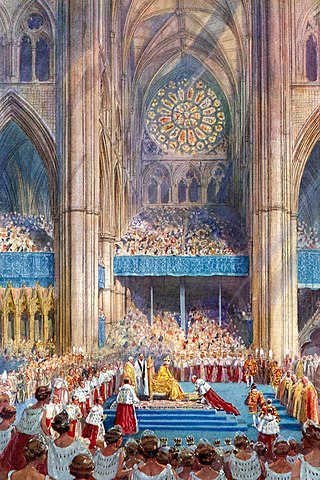Related Research Articles

The coronation of the monarch of the United Kingdom is an initiation ceremony in which they are formally invested with regalia and crowned at Westminster Abbey. It corresponds to the coronations that formerly took place in other European monarchies, which have all abandoned coronations in favour of inauguration or enthronement ceremonies. A coronation is a symbolic formality and does not signify the official beginning of the monarch's reign; de jure and de facto his or her reign commences from the moment of the preceding monarch's death or abdication, maintaining legal continuity of the monarchy.

The Groom of the Stool was the most intimate of an English monarch's courtiers, initially responsible for assisting the king in excretion and hygiene.

Francis George Hugh Seymour, 5th Marquess of Hertford, known as Francis Seymour until 1870, was a British army officer, courtier and Conservative politician. He served as Lord Chamberlain of the Household under Benjamin Disraeli from 1874 to 1879.

Francis Knollys, 1st Viscount Knollys, was a British courtier. He served as Private Secretary to the Sovereign from 1901 to 1913.
The Victoria Medal of Honour (VMH) is awarded to British horticulturists resident in the United Kingdom whom the Royal Horticultural Society Council considers deserving of special honour by the Society.
Groom of the Chamber was a position in the Household of the monarch in early modern England. Other Ancien Régime royal establishments in Europe had comparable officers, often with similar titles. In France, the Duchy of Burgundy, and in England while French was still the language of the court, the title was varlet or valet de chambre. In German, Danish and Russian the term was "Kammerjunker" and in Swedish the similar "Kammarjunkare".
The Master of the Robes is an office in the British Royal Household. He is responsible for the King's robes at times such as a coronation, the annual Order of the Garter service and the State Opening of Parliament. Since the reign of Edward VII, the office has only been filled for coronations. Below is a list of known office holders:
The King George V Silver Jubilee Medal is a commemorative medal, instituted to celebrate the 25th anniversary of the accession of King George V.
The office of Groom in Waiting was a post in the Royal Household of the United Kingdom, which in earlier times was usually held by more than one person at a time – in the late Middle Ages there might be dozens of persons with the rank, though the Esquires and Knights of the Body were more an important and select group. Grooms-in-Waiting to other members of the Royal Family and Extra Grooms in Waiting were also sometimes appointed. For the general history of court valets or grooms see Valet de chambre.

Sir William Sharington was an English landowner and merchant, a courtier of the time of Henry VIII, master and embezzler of the Bristol Mint, member of parliament, conspirator, and High Sheriff of Wiltshire.
The royal households of the United Kingdom consist of royal officials and the supporting staff of the British royal family, as well as the royal household which supports the sovereign. Each member of the royal family who undertakes public duties has their own separate household.

Capt. Sir Henry David Erskine of Cardross was a Scottish military officer and courtier who was the Serjeant-at-Arms of the House of Commons from 1885–1915.
References
- ↑ Holman, Peter (1994). Henry Purcell . Oxford University Press. p. 4. ISBN 0-19-816341-X.
Thomas Purcell groom of the robes.
- ↑ Chalmers F.S.A., Alexander (1812–1817). The General Biographical Dictionary.
- ↑ "John Copynger". Archived from the original on 2008-05-13. Retrieved 2008-03-26.
- ↑ C. E. Challis, 'Sharington, Sir William (c. 1495–1553), administrator and embezzler', in Oxford Dictionary of National Biography , Oxford University Press, September 2004
- ↑ Kaufman, Charles H. (1981). Music in New Jersey, 1655–1860. Fairleigh Dickinson Univ Press. p. 46. ISBN 0-8386-2270-4.
- ↑ letters and papers foreign and domestic of the reign of King Henry VIII
- ↑ Narasingha, Prosad,Sil 2001
- ↑ Tudor Placement And Statesman, select case studies page 71 18 February 1537 mentions Sir John as a Page
- ↑ "Domestic Occurrences". The Gentleman's Magazine. F. Jefferies: 308. March 1840.
Francis Seymour groom of the robes.
. - ↑ "Coronation order of service in full". BBC. May 6, 2023. Retrieved on June 27, 2023.